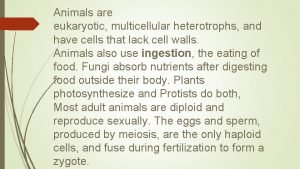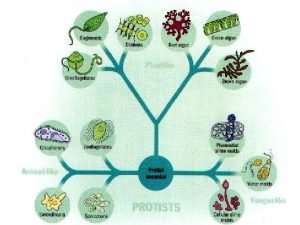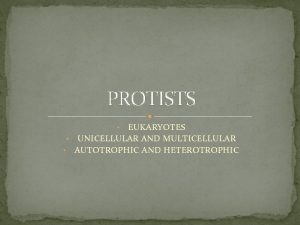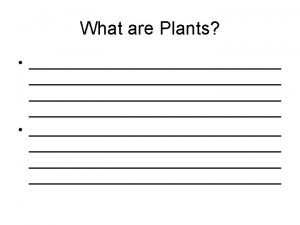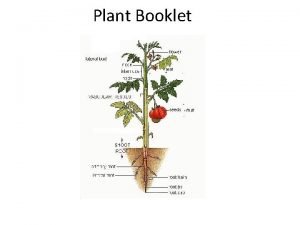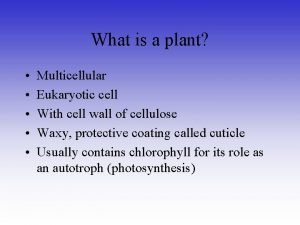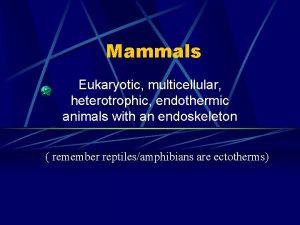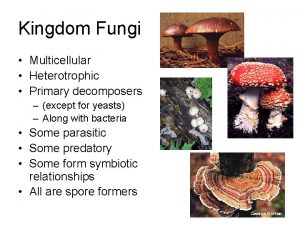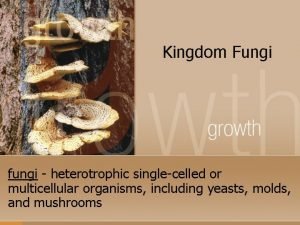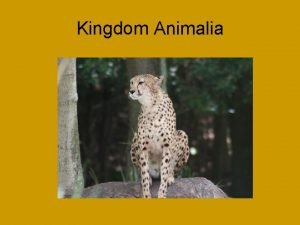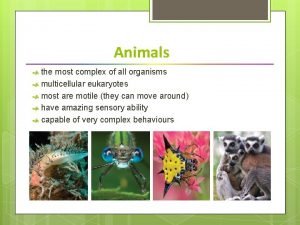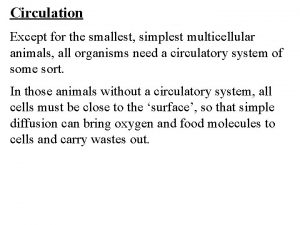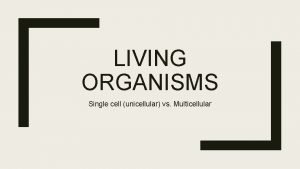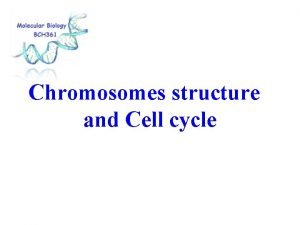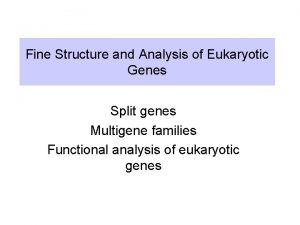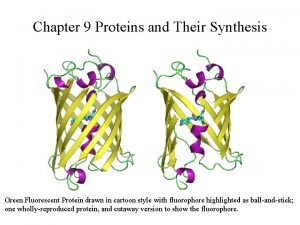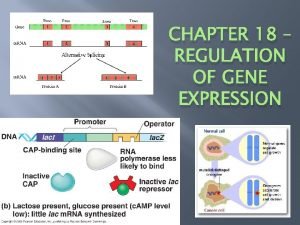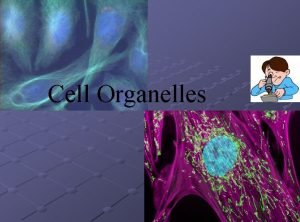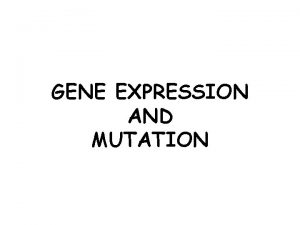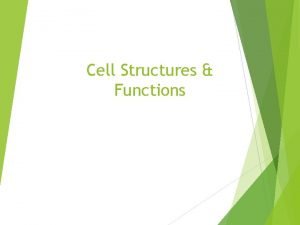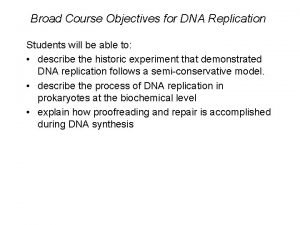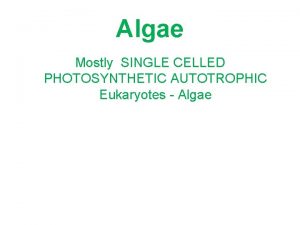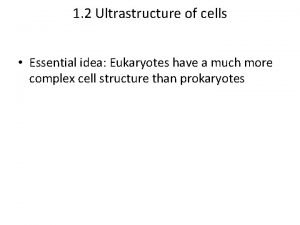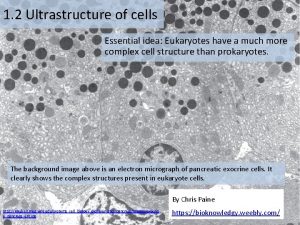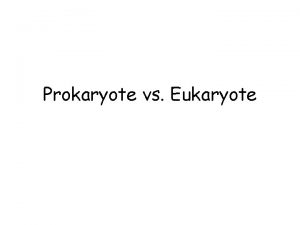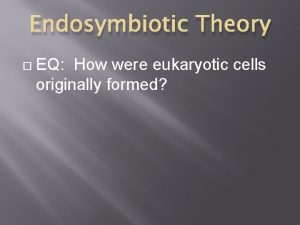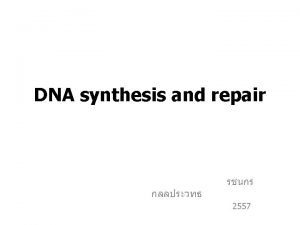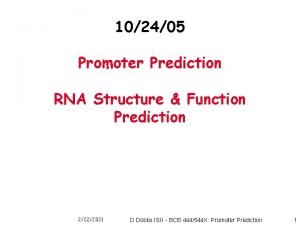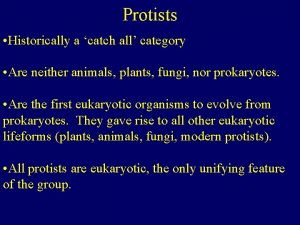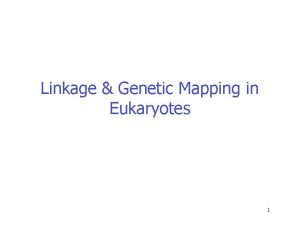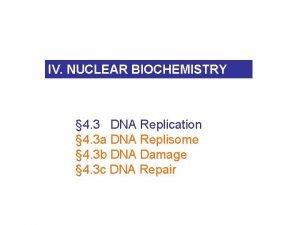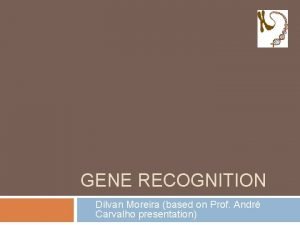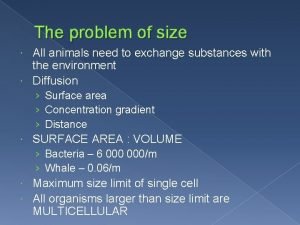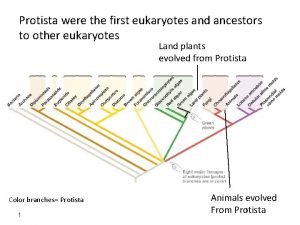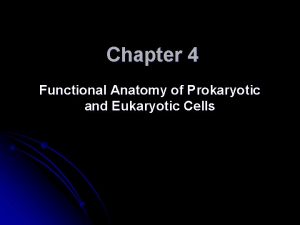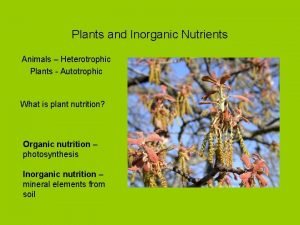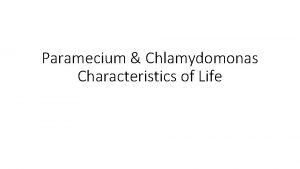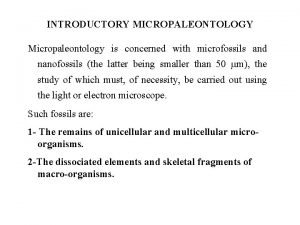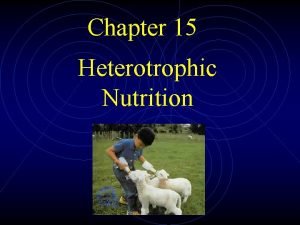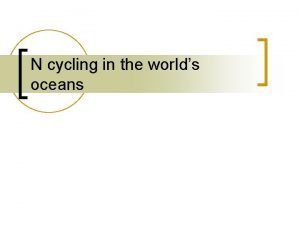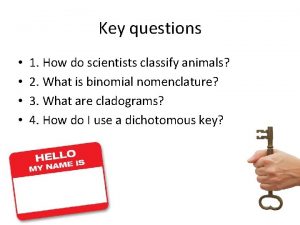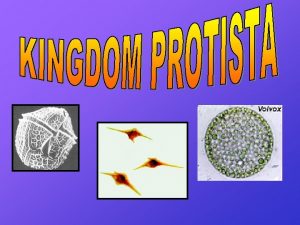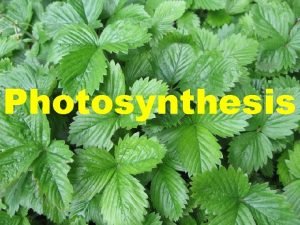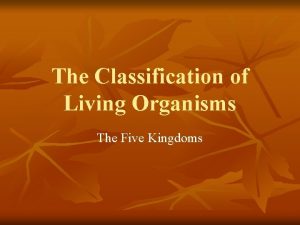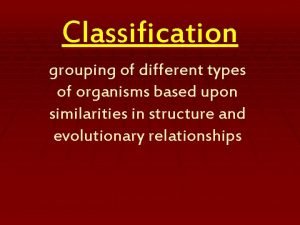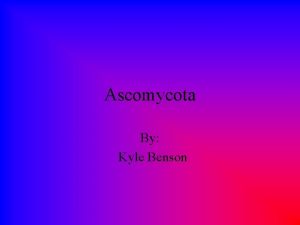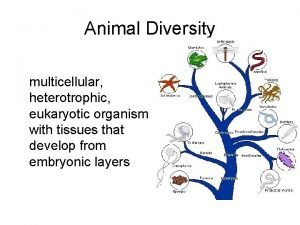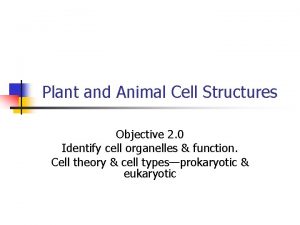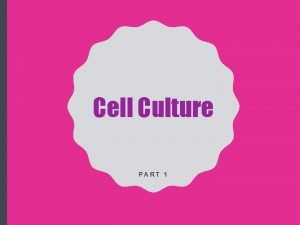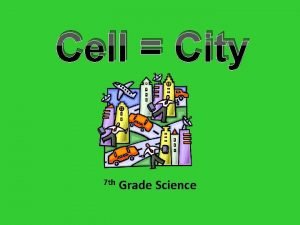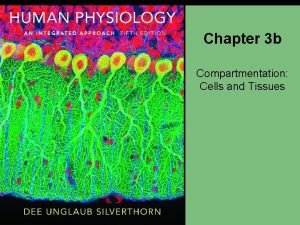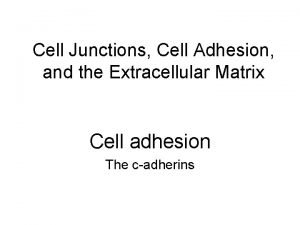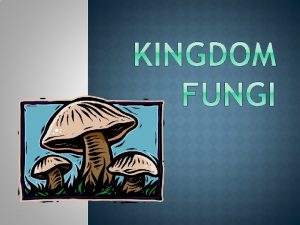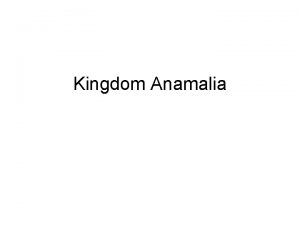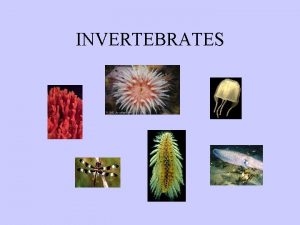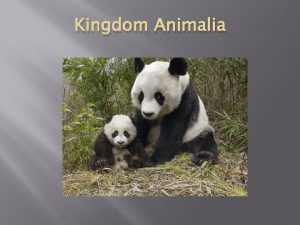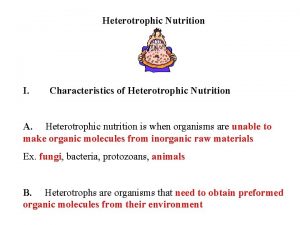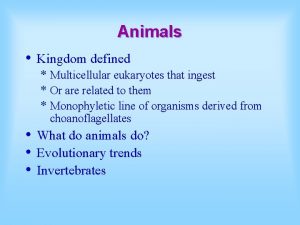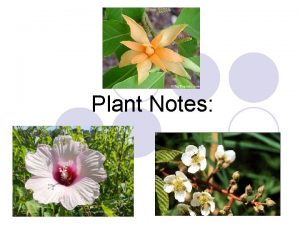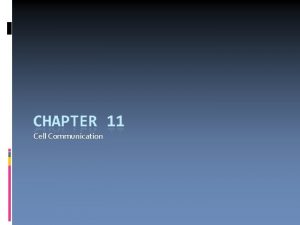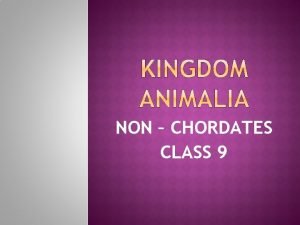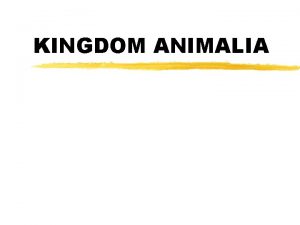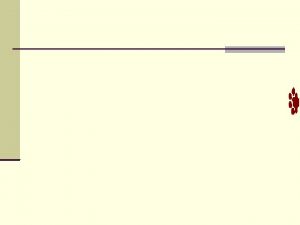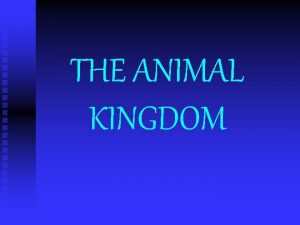ANIMALS Animals Definition multicellular heterotrophic eukaryotes no cell











































































































- Slides: 107

ANIMALS

Animals Definition: multicellular, heterotrophic, eukaryotes - no cell walls: support - connective tissue - prevalent mode of nutrition = ingestion - unique tissues: nervous and muscle

TWO Major Branches of Animals Parazoa: structurally simplistic: sponges Eumetazoa: develop true tissues Two Types: - Radiata - radial symmetry - Bilateria - bilateral symmetry - cephalization: head region - cluster of sensory organs

Radial & Bilateral Symmetry

Parazoa Sponges: Porifera - pore bearers - simple body plan - sessile as adults - filter feeders - pores

Parazoa - Porifera Sponge Filtration


Parazoa - Porifera


Spicules Spongin Silica (glass)

Glass Sponge

PHYLUM CNIDARIA: jelly fish, sea anemones, coral - aquatic Structure: Epidermis Gastrovascular Cavity - single opening mouth and anus Cnidoblasts - nematocysts - stinging cells Types: venom, barb, tangling

Cnidaria

Cnidaria

Cnidaria

Cnidocyte and Nematocyst

Youtube - Cnidaria • • • Sea Anemone Nematocyst Firing Jellyfish Swimming Jellyfish Lake Giant Jellies

• Triploblastic: Bilateria – Acoelomates, psuedocoelomates and coelomates

Development of Tissue Layers Ectoderm - develops into outer coverings and nervous system Endoderm - lines digestive tube (archenteron) - associated digestive organs - liver, lungs Mesoderm - third germ (tissue) layer - only in eumetazoa - forms muscles and other organs between endoderm and ectoderm

Coelom Types

Purpose of the Coelom - protection: cushion from shock - space for growth - space for movement - organs can shift - movement: earthworms

Acoelomates Phylum PLATYHELMINTHES: unsegmented flat worms EX: Planaria, Fluke, Tapeworm Ecological: food chain, parasites

Acoelomates • Unsegmented Flatworms • Planaria – Turbellaria Planaria Regeneration Marine Flat Worm

Trematoda - Fluke

Cestoidia - Tapeworm

Pseudocoelomates NEMATODA: unsegmented roundworms - complete digestive tract - use pseudocoelom to move - hydrostatic pressure - also as circulatory system Ecological Roles: - decomposers - aerate soil - pests - parasites - Trichinosis

Nematode • Unsegmented Roundworms

Filiariasis/Elephantiasis

Coelomates: Protostomes MOLLUSCA: snails, slugs, shellfish, octopuses, squid Three basic structures muscular foot -movement visceral mass - internal organs mantle - secretes shell - may or may not have shell: external or internal Feeding: Filter Feeding: shell fish - incurrent and excurrent siphons Radula - rasping - tongue-like organ Beak - octopus and squid

Mollusca

Gastropoda - stomach footed - snails and slugs - aquatic or terrestrial - cephalization Bivalvia - clams, oysters, scallops - no cephalization - two shells - foot - digging or anchoring Cephalopoda - head footed - squid and octopuses - foot - head and divided into tentacles - closed circulatory system - all blood contained in veins and arteries - complex brains - learn and behave


Feeding Methods - Radula Slug Feeding http: //youtube. com/watch? v=KB 3 sc. Gais-4&feature=related Snail Eating http: //youtube. com/watch? v=F-SBGWAUbx. A

Feeding Methods - Beak

Cephalopod Videos Octopus and Coconut Giant Octopus II Octopus and Diver Octopus vs. Shark Nova Science Now

ANNELLIDA: segmented round worms - coelom separated into segments by Septum

Annelids - Oligocheta


Earthworm Locomotion – Hydrostatic Compression

Annelids – Hirudinae - Leech

Polychaeta

ARTHROPODA: General Characteristics - Segmented bodies - Exoskeletons of chitin - Jointed Appendages - Gas Exchange: Gills - aquatic Tracheal tubes Book lungs - Ecological: food chain pollination pests parasites

Classification Arachnida: spiders, scorpions, ticks, mites 4 pairs of walking legs lack antenna one or two body segments Spiders: chelicerae - pedipalps webs Respiration: Book Lungs No Antenna

Arachnids - Spiders


Spider Videos • Jumping Spiders: http: //www. youtube. com/watch? v=UC_g. Xr. C 6 oyshttp: //youtube. com/watch? v=z. Xhdr 0 Tp. Ow. Y • Trapdoor spider http: //youtube. com/watch? v=Zj. Ir 2 lw. G 5 Ug • Web Spiders http: //www. youtube. com/watch? v=1 Jl. LLpa. Ck. I 4 http: //www. youtube. com/watch? v=Eu. T PY 12 k. LS 4

Myriapods: jawlike feeding appendages - mandibles antenna Diplopoda: two pairs of legs per body segment = millipede - vegetarians - decaying vegetation Chilopoda: one pair of legs per body segment = centipedes - carnivorous

Myriapods • Diplopoda • http: //youtube. com/watch? v=kkx. S 6 w. HWOk&feature=related • Chilopoda

Insects: Entomology - most abundant class Body Plan 3 segments: Head: antenna and mandibles Thorax: legs and wings - only flying arthropods Abdomen


NOT THIS


Life cycle - complete metamorphosis - incomplete metamorphosis





Insect Metamorphosis • • • Monarch: Caterpillar Hatching Monarch: Caterpillar to Chrysalis Monarch: Chrysalis to Adult Water Bug Ladybug laying eggs



Crustaceans crabs, shrimp, lobsters, pill-bugs (roly-poly) - 19 pairs of appendages on head, thorax and abdomen - gas exchange: gills or across thin areas of cuticle - copper based blood - sexual reproduction

Crustacean



Echinodermata: - radial symmetric - bilateral larval stage - spiny-skinned animals - hard plates of calcium carbonate under skin - water vascular system - hydraulic canals - push tubed feet - little suction cups - movement and predation - High capacity for regeneration

Echinoderms Sea Star Eating



Phylum Chordata

Classification Superclass Agnatha: jawless fish • cartilaginous skeleton • no lower jaw or paired appendages EX: lamprey NOT Hagfish – lack vertebrae (craniate)

Agnatha

Superclass Gnathostomata I: Jawed Fishes Class Chondrichthyes: cartilagenous fishes • Cartilagenous skeleton • Gills for respiration • Jaws and paired fins – Toothlike Scales – Lateral Line: small organs that sense pressure change EX: sharks and rays

Reproduction: Sexual - internal fertilization Oviparous: lay eggs externally Ovoviparous: retain eggs in oviduct Viviporous: retain eggs in a uterus and nourished via a placenta

Interesting Tid-bits: - floatation - oil stored in the liver Denser than water - sink - move to keep water passing over gills or pump water over gills using jaws and pharynx

Chondrichthyes • Sharks, rays • Shark birth: http: //www. youtube. com/watch? v=Lf. Qg. RCg 1 b. NA • Great White




Osteichthyes: bony fish Skeleton of calcium phosphate Paired fins Bony plate like scales Lateral Line - schooling of fish Operculum: protective flap covering gills - moves water over gills Swim Bladder: internal air sac = buoyancy Reproduction: typically external fertilization - spawning Subclasses: Ray finned fishes: bony rays in fins Lobed finned fishes: fins have bone and muscle in them - includes coelocanth and lungfishes

FISH GRAMMAR: one individual = fish two or more of the same species = fish more than one species = fishes SO: Is it “one fish, two fish, red fish, blue fish. ”, or “one fish, two fishes, red fish, blue fish. ”


• Archer Fish • Angler Fish

Class Amphibia Characteristics: - Mostly External Fertilization of Eggs - parental care usually absent: lots of eggs - parental care present: fewer eggs - requires moist environment for development - egg - no protective coating - respiration: gills, skin or lungs


• • Frog Development Darwin Frogs Fighting


Moving From Water To Land: a few changes Reproduction: Amniotic Egg: - extraembryonic membranes - not part of the embryo Shell: protection - prevent dehydration Albumin: storage of nutrients Yolk: nutrients Chorion: gas exchange Allantosis: waste, gas exchange


Class Reptilia Respiration: Lungs Skin: dry and scaley - plates of keratin - prevent dehydration - protection Reproduction: Leathery Eggs on land: various amounts of parental care Metabolism: generally low - “cold blooded” ectotherms don’t use metabolism to regulate body temperature Three Chambered heart (except crocodilians)

Interesting Bits • The turtle’s shell is actually its spine and ribs. • Chelonia and Crocodilian gender is determined by the temperature of incubation. • Some snakes give birth to young.



Class Aves thought to have evolved from dinosaurs - flying reptiles Characteristics: - Bones: internal, honeycomb structure, “hollow” - very light - less muscle for movement - even lighter - Beaks - no teeth - shape determines diet Golden Eagle -bird’s eyes takes up about 50 percent of its head; our eyes take up about 5 percent of our head. To be comparable to a bird’s eyes, the eyes of a human being would have to be the size of baseballs.



Feathers: keratin Contour: shaft, vein, barbule, and hook Principles of Flight: Bournoulli’s Principle Downy: insulation Body Temperature: Endothermic - high metabolism to maintain body temperature - due to Respiratory System and Four chambered heart


Flight: Bernoulli’s Principle

Reproduction Internal Fertilization Hard shelled eggs High amounts of Parental care (usually) Hornbill Cowbird II Complex mating rituals: nests, displays Bird of Paradise Bower Bird Magpies use shiny objects

Class Mammalia Characteistics: Hair Nurse young - intensive parental care endotherms: high metabolism, four chambered heart Reproduction: internal fertilization - mostly internal development

Classification Monotremes: egg layers - leathery shells - hatch, very undeveloped - nurse - specialized glands that produce milk - no nipples EX: platypus and echidnas (spiny anteaters)


• Platypus

Marsupials: pouch mammals - young born very immaturely - crawl from reproductive tract to the pouch - no assistance from the mother nurses and grows Ex: Kangaroo, Possum, Wombat

• Kangaroo Birth • Wombat

Eutherian - placental mammals - longer period of pregnancy - larger animal = longer gestation - nourished by layers of tissue called placenta in uterus

• Elephant Birth • Whale Cooperation • Whale vs. Shark
 Multicellular heterotrophs
Multicellular heterotrophs Protozoa are polyphyletic
Protozoa are polyphyletic Multicellular heterotrophic
Multicellular heterotrophic Meaning of multicellular
Meaning of multicellular Plants are multicellular eukaryotes
Plants are multicellular eukaryotes Plant tissue
Plant tissue Are plants multicellular eukaryotes
Are plants multicellular eukaryotes Are cell walls prokaryotic or eukaryotic
Are cell walls prokaryotic or eukaryotic The eutherian mammals for plantigale is patagonian cavy.
The eutherian mammals for plantigale is patagonian cavy. Spider phylum
Spider phylum Is the kingdom fungi multicellular or unicellular
Is the kingdom fungi multicellular or unicellular Osteichtheyes
Osteichtheyes Are animals multicellular
Are animals multicellular What is something unicellular
What is something unicellular Simplest multicellular animals
Simplest multicellular animals Unicellular vs multicellular
Unicellular vs multicellular Is a nerve cell multicellular or unicellular
Is a nerve cell multicellular or unicellular Cell division in multicellular organisms
Cell division in multicellular organisms Transcription initiation in eukaryotes
Transcription initiation in eukaryotes Lac operon inducible or repressible
Lac operon inducible or repressible Eukaryotes vs prokaryotes
Eukaryotes vs prokaryotes Characteristics of the eukarya domain
Characteristics of the eukarya domain Fine structure analysis of eukaryotes
Fine structure analysis of eukaryotes Translation in bacteria vs eukaryotes
Translation in bacteria vs eukaryotes Prokaryotes vs eukaryotes gene regulation
Prokaryotes vs eukaryotes gene regulation Types of organelles
Types of organelles Eukaryotic cell
Eukaryotic cell Prokaryotic cell and eukaryotic cell similarities
Prokaryotic cell and eukaryotic cell similarities Diff between prokaryotes and eukaryotes
Diff between prokaryotes and eukaryotes Cytoskeleton nickname
Cytoskeleton nickname Diff between prokaryotes and eukaryotes
Diff between prokaryotes and eukaryotes Linear chromosomes in eukaryotes
Linear chromosomes in eukaryotes How many dna polymerase in eukaryotes
How many dna polymerase in eukaryotes Types of dna polymerase in eukaryotes
Types of dna polymerase in eukaryotes Prokaryote vs eukaryote
Prokaryote vs eukaryote Spirogyra unicellular or multicellular
Spirogyra unicellular or multicellular Eukaryotes main idea
Eukaryotes main idea Eukaryotes main idea
Eukaryotes main idea Prokaryotes vs eukaryotes
Prokaryotes vs eukaryotes Multiple choice questions on prokaryotes and eukaryotes
Multiple choice questions on prokaryotes and eukaryotes Anaerobic bacteria
Anaerobic bacteria Dna polymerase proofreading
Dna polymerase proofreading Gene prediction in prokaryotes and eukaryotes
Gene prediction in prokaryotes and eukaryotes Prokaryotic and eukaryotic cells chart
Prokaryotic and eukaryotic cells chart How do protists store carbohydrates
How do protists store carbohydrates Genetic linkage and mapping in eukaryotes
Genetic linkage and mapping in eukaryotes Where is the site of dna replication in eukaryotes
Where is the site of dna replication in eukaryotes Polimerase
Polimerase Heterogamy in eukaryotes
Heterogamy in eukaryotes Ancestors
Ancestors Prokaryotic cells vs eukaryotic cells
Prokaryotic cells vs eukaryotic cells Prokaryotic cell wall
Prokaryotic cell wall Anatomy of prokaryotes and eukaryotes
Anatomy of prokaryotes and eukaryotes Inorganic plants
Inorganic plants Cavuole
Cavuole Diatoms unicellular or multicellular
Diatoms unicellular or multicellular Ascomycots
Ascomycots Micropaleontology lecture notes
Micropaleontology lecture notes Herbivore root word
Herbivore root word Holozoic nutrition
Holozoic nutrition Heterotrophic denitrification
Heterotrophic denitrification Are rotifers autotrophic or heterotrophic
Are rotifers autotrophic or heterotrophic Paramecium heterotrophic or autotrophic
Paramecium heterotrophic or autotrophic Heterotrophic plants
Heterotrophic plants What is heterotrophic nutrition
What is heterotrophic nutrition 5 kingdoms
5 kingdoms Is euglena autotrophic or heterotrophic
Is euglena autotrophic or heterotrophic Ascomycetes heterotrophic
Ascomycetes heterotrophic Heterotrophic eukaryotic organisms
Heterotrophic eukaryotic organisms Https://a-z-animals.com
Https://a-z-animals.com Consumers producers and decomposers
Consumers producers and decomposers Detritus food chain
Detritus food chain Animals that eat both plants and animals
Animals that eat both plants and animals Multicellular vs unicellular
Multicellular vs unicellular Diagram of cell
Diagram of cell Cell city project animal cell
Cell city project animal cell Advantages of diaphragm cell
Advantages of diaphragm cell Prokaryotic cell vs eukaryotic cell
Prokaryotic cell vs eukaryotic cell Animal and plant cell venn diagram
Animal and plant cell venn diagram Electrochemical cell vs galvanic cell
Electrochemical cell vs galvanic cell Dry cell vs wet cell
Dry cell vs wet cell Plant animal cell venn diagram
Plant animal cell venn diagram Function of cells
Function of cells Plant cell structure
Plant cell structure Difference between plant cell and bacterial cell
Difference between plant cell and bacterial cell Cell wall cell membrane
Cell wall cell membrane 10 cm dish surface area
10 cm dish surface area Cell line vs cell strain
Cell line vs cell strain Cell city project
Cell city project Primary battery and secondary battery
Primary battery and secondary battery Whats the difference between plant and animal cells
Whats the difference between plant and animal cells Cell-cell junction
Cell-cell junction Cell-cell junction
Cell-cell junction What cell organelle is like lysol spray cleaning the cell
What cell organelle is like lysol spray cleaning the cell Section 10-2 cell division
Section 10-2 cell division Prokaryotic cell and eukaryotic cell
Prokaryotic cell and eukaryotic cell Carbohydrate side chain
Carbohydrate side chain Chapter 4 cell theory and cell study
Chapter 4 cell theory and cell study Cell organelles graphic organizer
Cell organelles graphic organizer Idealized animal cell
Idealized animal cell Walker cell and hadley cell
Walker cell and hadley cell Cell cycle and cell division
Cell cycle and cell division Biology.arizona.edu/cell bio/activities/cell cycle/01.html
Biology.arizona.edu/cell bio/activities/cell cycle/01.html Cell division phases
Cell division phases Matlab string builder
Matlab string builder Voltaic vs electrolytic cells
Voltaic vs electrolytic cells Flexible covering of an animal cell
Flexible covering of an animal cell Single celled and multi celled organisms
Single celled and multi celled organisms
